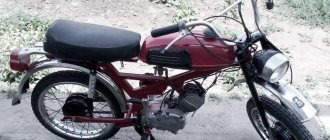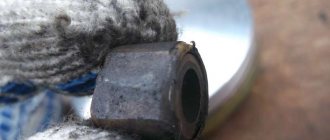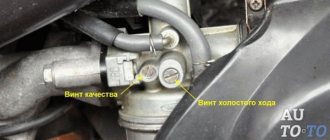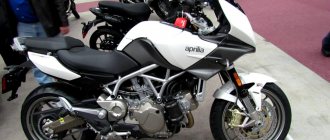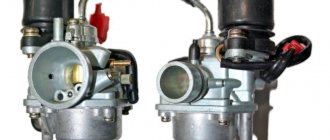Liked? Share with your friends:
Our company SAN-MOTO carries out comprehensive repairs of scooters of any complexity and scheduled maintenance of Japanese mopeds, including diagnostics, prevention, adjustment and replacement of mechanical or electrical parts and assemblies.
As you already know, no matter how high-quality and reliable a thing or mechanism is, sooner or later, it will in any case require some repairs.
Japanese scooters are no exception to this rule. Despite the amazing reliability and durability of Japanese motorcycles in general, from time to time it is necessary, if not repaired, then certainly scheduled maintenance. Any of your scooter's systems may need repairs: the engine, transmission, steering or brake system.
And, although many malfunctions, with the proper experience and certain knowledge, can be easily eliminated practically “on the knees” in a garage, work such as overhauling the engine or repainting parts will require special premises and equipment.
We can repair your moped and carry out full maintenance of all its systems and mechanisms, including the necessary spare parts. In our service, you can make the necessary repairs to your scooter without worrying about purchasing the necessary spare parts and consumables, since the bulk of the most common “consumables” are always in stock. But if you need something, our craftsmen will quickly resolve this issue: they will select and deliver the necessary part, and at the lowest prices.
In addition, we offer a service for full or partial painting of the scooter with acrylic or metallic, with high-quality restoration of all plastic parts. If you want to repaint your scooter in a different color, we will be happy to help you select and purchase paint of the desired color and shade. After painting, all plastic elements must undergo fine grinding and polishing, which gives ideal quality to our work. Reupholstering the scooter seat will completely and irrevocably change the appearance of the moped for the better. We offer a wide range of leather and leatherette materials with different textures and colors.
Price list for maintenance of scooters and mopeds
Maintenance (MOT) of a 2T scooter |
| Transmission diagnostics and variator cleaning |
| Changing the oil in the rear wheel gearbox |
| Diagnostics of the chassis and steering system |
| Cleaning or replacing the air filter |
| Cleaning and adjusting the carburetor |
| Cleaning and adjusting brakes |
| Electrical diagnostics |
| Price: 2000 rubles *excluding the cost of consumables |
Maintenance (MOT) of a 4T scooter |
| Transmission diagnostics and variator cleaning |
| Changing the oil in the rear wheel gearbox |
| Diagnostics of the chassis and steering system |
| Cleaning or replacing the air filter |
| Cleaning and adjusting the carburetor |
| Cleaning and adjusting brakes |
| Changing the engine oil |
| Electrical diagnostics |
| Price: 2500 rubles *excluding the cost of consumables |
Dismantling engines and gearboxes of Alpha mopeds
In order to disassemble the engine you need to do the following:
- Remove the screws located in the intake manifold.
- Remove all cylinder covers and screws.
- Remove the cylinder head.
The gearbox is disassembled to replace parts such as rotors, clutches or cylinders.
In order to disassemble the gearbox you need to do the following:
- Remove the retaining ring, then the drive gear is removed.
- Unscrew the locking gear screw, then remove the gear shift mechanism itself
- Remove the shift fork and shaft, then the crankshaft and drum.
- Put everything back to front.
And in conclusion, we would like to say that although the Alfa moped rarely breaks down, it is not worth disassembling and repairing it yourself if you lack knowledge and experience, or you are simply not completely sure that you can handle it, since if you want to save money, you can lose a lot more . Therefore, you should not refuse the services of professionals. But still, if you decide to repair the engine of the Alpha 110 moped yourself, do not forget to use the diagram or training video. And if there is no diagram, then mark the location of the parts on a piece of paper so as not to forget.
Alpha moped engine assembly (part 1)
Price list for repair of scooters and mopeds
General maintenance work | |
| Drum brake adjustment | 100 rub |
| Replacing the air filter element | 300 rub |
| Bleeding the disc brake system | 600 rub |
| Changing engine oil (4T) | 800 rub |
| Changing the oil in the gearbox | 400 rub |
| Replacing the spark plug | 150 rub. |
| Replacing a light bulb | 100 rub |
| Replacing disc brake pads | 600 rub |
| Replacing drum brake pads | 600 rub |
| Battery replacement | 300 rub |
| Replacing mirrors | 150 rub. |
Engine work | |
| Replacing the CPG (2T/4T) | 4500/5000 rub. |
| Crankshaft replacement | 4500 rub. |
| Replacing crankshaft bearings | 5500 rub. |
| Replacing crankshaft oil seals | 1700 rub. |
| Valve adjustment (4T) | 1300 rub. |
| Replacing the intake manifold | 550 rub. |
| Muffler replacement | 400 rub |
| Replacing the engine assembly | 3500 rub. |
| Replacing the vacuum fuel pump | 300 rub |
| Carburetor cleaning | 900 rub. |
Transmission work | |
| Replacing variator rollers | 1000 rub |
| Replacing the variator | 1000 rub |
| Replacing the variator belt | 1000 rub |
| Replacing the torque driver | 700 rub |
| Replacing the torque driver spring | 1300 rub. |
| Replacing the clutch plate | 1300 rub. |
| Reducer gear replacement | 2000 rub |
| Replacing gear bearings | 2500 rub. |
| Repairing or cleaning the kickstarter mechanism | 800 rub |
Wheel and suspension work | |
| Replacing front shock absorbers (per pair) | 1000 rub |
| Oil fork repair | 2500 rub. |
| Replacing the rear shock absorber | 600 rub |
| Replacing the shock absorber silent block | 600 rub |
| Replacing the speedometer drive | 800 rub |
| Replacing the traverse | 2300 rub. |
| Replacing the front wheel | 600 rub |
| Replacing the rear wheel | 1000 rub |
| Tire replacement | 500 rub |
| Replacing the camera | 300 rub |
Brake system work | |
| Replacing the brake caliper | 600 rub |
| Replacing the front brake cable | 900 rub. |
| Replacing the rear brake cable | 1300 rub. |
| Replacing the brake machine | 1000 rub |
Electrical work | |
| Electrical equipment diagnostics | 1000 rub |
| Replacing the electric starter | 1400 rub. |
| Replacing the headlight | 800 rub |
| Dashboard replacement | 1000 rub |
| Bendix replacement | 1000 rub |
| Electric starter repair | from 1500 rub |
| Generator replacement | 1300 rub. |
| Generator repair | from 1500 rub |
| Replacing the ignition switch | 900 rub. |
| Replacement of electrical equipment parts | from 800 rub |
Additional work | |
| Dismantling and installation of plastic parts (per piece) | from 200 rub |
| Painting of plastic parts with preparation (per piece) | from 700 rub |
| Repair/restoration of plastic parts (per piece) | from 1000 rub |
| Installing the side step | 500 rub |
| Seat reupholstery | from 700 rub |
| Alarm installation | from 2000 rub |
- < Rent and rental of scooters in Moscow
- Urgent purchase of scooters and mopeds >
DIY 4-stroke scooter engine repair instructions
- Remove the engine from the scooter. We install the scooter as stable as possible. We remove the trunk. Disconnect all wires from the engine and the throttle cable from the carburetor. Remove the gas hose and vacuum filter. Disconnect the rear shock absorber. After the engine is separated from the frame, unscrew the nut on the mounting axle and remove the axle. After removal, it is advisable to wash the engine.
- Removing the cylinder head. It is necessary to clean the chamber from carbon deposits. In order to remove the head, you must first disconnect all the “extra” parts. Then the chain tensioner bolt and locking bolts are unscrewed. Then we turn the flywheel until the T designation matches the one on the engine body. We unscrew the bolts that secure the cylinder and remove the chain, and then the cylinder head itself.
- Valve clearances must be adjusted if metallic knocking occurs. The principle of operation is as follows: the valve mechanism cover is removed. We correlate the mark on the flywheel with the mark on the engine housing. We measure the gap between the adjusting screw and the valve stem. When increasing or decreasing the gap, we adjust by rotating the screw.
As practice shows, it is better to entrust major engine repairs to professionals, since many nuances arise that the average driver does not pay attention to, but which in the future can create even bigger problems and then more expensive repairs will be required. A video about repairing a 4-stroke scooter will introduce you to the main aspects of repair.
Problems when paying with bank cards
Sometimes difficulties may arise when paying with Visa/MasterCard bank cards. The most common of them:
- There is a restriction on the card for paying for online purchases
- A plastic card is not intended for making payments online.
- The plastic card is not activated for making payments online.
- There are not enough funds on the plastic card.
In order to solve these problems, you need to call or write to the technical support of the bank where you are served. Bank specialists will help you resolve them and make payments.
That's basically it. The entire process of paying for a book in PDF format on car repair on our website takes 1-2 minutes.
If you still have any questions, you can ask them using the feedback form, or write us an email at [email protected]
Scooter diagnostics
Diagnostics is necessary to understand the scope of work and the list of possible hidden problems, the condition of consumables (spare parts). After a general diagnosis of the scooter, the list of work necessary to eliminate all problems will be clear. We will compile a list of necessary spare parts for restoration repairs. You can order all spare parts from us, or provide them yourself. We always have all the technical fluids (fuels and lubricants) from various manufacturers necessary for servicing scooters.
Tools
- Generator puller (you can make it yourself)
- Variator puller (you can make it yourself)
- Kickstart sprocket puller (157QMJ engine only)
- Heads for 8, 10, 12, 17 mm
- Phillips and flathead screwdriver
- Small hammer
- Wish
Most Chinese four-stroke scooter engines can be divided into two main types
- First type: 139QMB-series engine. This engine is very popular in the CIS countries and is installed on most Chinese four-stroke scooters
- Second type: 157QMJ-series engine. This engine has a larger volume than the first and, due to its higher price, is not so popular
Essentially, these two engines are a copy of the ancient Honda GY6 and differ from each other in displacement, kickstarter design, oil pump drive and electric starter drive. In all other respects, these engines are identical.
Typical 139QMB, in fact JL1P139QMB-2
And this is what a typical 157QMJ looks like, in fact LK162QMK
How to check the brake system
One of the mandatory components that needs to be checked during maintenance is the brake system. The wear of its components depends on driving conditions and driving style. If the rider brakes frequently, rides on dirt roads or off-road, the brake linings will wear out quickly. Therefore, system setup may be required much faster than indicated in the manufacturer's instructions. Also, if the components are damaged, the rider will have to buy new spare parts for the motorcycle.
Important! Regularly check the condition of the brake friction linings. If the thickness in any area becomes less than 1.5 mm, the brake pad must be replaced.
Front brake maintenance is carried out according to the following scheme:
- Loosen the adjusting nut.
- Adjust the cable length.
- Check the brake lever travel. It should be approximately 8-15 mm;
- Lower the lever. Remember that the wheel should rotate freely without touching the pads.
After the procedure, you need to check whether the adjusting nut is tightly clamped. It should touch the surface of the pin cylinder with its concave end. The rear brake is adjusted according to the following scheme:
- The adjusting nut is twisted.
- The cable length is adjustable.
- Check the travel at the end of the brake pedal. It should be 20-30 mm.
- The pedal is released. In this case, the wheel should spin freely without touching the brake.
After completing the above steps, the adjusting nut is tightened. In this case, it should be adjacent to the pin with its concave end.
How to choose the right oil for a moped?
After the driver has ridden the moped for 500 km, the oil in the crankcase needs to be changed. It is also necessary to periodically check the lubricant level in the crankcase. And to carry out this procedure, you need to place the bike on a level area.
After this, unscrew the dipstick, which is located to the right of the crankcase. It is used to check the oil level. There should be a mark on the dipstick, which will indicate the amount of lubricant. If there is less oil than necessary, you need to add a little liquid. The parameters of the oil used for the Alpha moped are as follows:
- Composition for a four-stroke engine.
- API SE, SF.
- SAE 15W40.
Please note that you should not mix different types of oils. Also, do not pour compounds for two-stroke engines into 4-stroke internal combustion engines. If fluid from one manufacturer was poured into the crankcase, but the driver wants to use a composition from another brand, the system must first be flushed. You can buy the necessary spare parts and high-quality components for maintenance in the online store.
Engine operating principle
It's hard to see in the video, but the rotation occurs eighty-three times within a second.
In addition, only in a four-stroke engine the bearings on the crankshaft with the piston are located inside an oil bath, which can increase the engine life by several tens of times. The cylinder-piston pair, as can be seen from the video, acts as a fuel pump. Ensuring that the necessary substances are able to fill and leave the combustion chamber at the required time, as shown in this video, created a gas distribution mechanism, as required by the technical manual. What influences the process of choosing a design for such a mechanism? This is the shape of the combustion chamber, the presence of which is described in the manual. It is capable of determining the parameters of almost every system in the engine, since it is certainly the place where the latent energy of gasoline vapors is converted into movement.
The principle of operation of the engine combustion chamber



